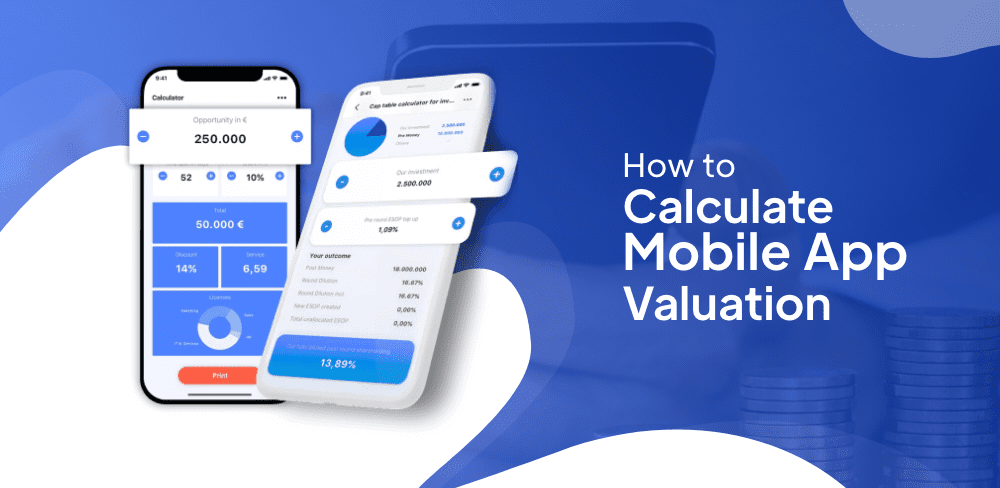Are you a tech enthusiast, an aspiring app developer, or a business owner considering getting into the mobile app space? To make smart decisions, one needs to understand the importance of a mobile app. Whether you’re planning to sell your app, secure funding, or simply gauge its worth, it is vital to calculate mobile app valuation.
In this blog post, we’ll demystify the process and provide you with a clear, step-by-step guide to determining the value of your mobile app. We’ll explore the key factors influencing app valuation and share real-world examples to help you make strategic decisions and navigate the dynamic world of app development and investment.
So, if you’re ready to put a price tag on your app, let’s dive into the exciting world to calculate mobile app valuation!
What is Mobile App Valuation?
Mobile app valuation is the process of assessing the monetary worth of a mobile application, considering factors like user base, revenue, growth potential, and market trends. It helps determine the app’s market value, aiding investment decisions, mergers, acquisitions, and sales. App valuation methods often involve analyzing key performance metrics, such as user acquisition cost, retention rates, and revenue streams, and considering the competitive landscape and industry-specific benchmarks.
App valuation methods often involve analyzing key performance metrics, such as user acquisition cost, retention rates, and revenue streams, and considering the competitive landscape and industry-specific benchmarks.
The valuation outcome is crucial for mobile app developers seeking funding and potential buyers or investors looking to make informed decisions about the app’s financial prospects.
Factors to Consider for Mobile App Valuation
A thorough analysis of several factors, such as financial performance, the user base, current market conditions, and growth potential, determines the value of a mobile application. So, as per an experienced IT company, below are the crucial factors that will guide you in calculating the mobile app valuation of your app.
● Financial Data
You must track all your finances as you have invested so much money in your mobile app. Financial data will help you determine the actual value of your application. Economic data for your mobile app includes historical data, including but not limited to revenue, expenses, and profits. It will allow you to establish a baseline.
● Revenue Streams
Most mobile applications have one or more revenue streams. These include, but are not limited to, in-app purchases, subscriptions and advertising, and affiliate marketing. Ads generated $ 567.49 billion in revenue in 2022 from nearly 5.195 million applications. Get detailed information about the contribution of each revenue stream to your overall income by analyzing all listed revenue streams.
● User Metrics
App metrics are essential for app business valuation. You can get detailed user metrics, including active users, new user acquisition rates, the amount you spent on acquiring new users, user engagement rates, user retention rates, targeted user base age groups, demographics, and user behavior.
● Competitive Analysis
You will see that many similar apps on the market offer the same services as yours. Let’s use the mobile app for on-demand food delivery as an example. Numerous applications, like DoorDash and Uber Eats, are available in the app store.
Find out who your competitors are and what their valuation is. You can use their information, such as recent funding rounds and transactions, to evaluate your current position. It can also help you to understand their USP that you can use in your own business.
● Intellectual Property
Are you aware of any intellectual property, patents, or trademarks associated with your application? It can add value to your app. Consider them when you calculate mobile app valuation.
● App Maturity level
Your app’s maturity level will affect its valuation. If your app is only a few months old, it may grow slowly or not at all during this stage. It’s difficult to predict if the app will succeed at this point. At this point, there won’t be much of an influence from your app’s growth. If your app is still growing, you may not see rapid growth, but consistency will help you determine the app’s value.
Steps to Calculate Mobile App Valuation
Now that you know the factors to consider before you calculate mobile app valuation, we will discuss the steps to calculate mobile app valuation recommended by an IT consulting firm. So, let’s begin.
1) Create a Plan for Measuring ROI
Decide how you will measure mobile app ROI before building the app. You may use the number or checkouts to measure success if it is an e-commerce application. You may want to determine how many employees use the app and what kind of efficiency it brings. Spend some time and ask for input from critical stakeholders.
2) Calculate the Customer’s Lifetime Value
The app Value Calculation of the Customer Lifetime Value (CLV) of each new client if the app is consumer-facing. How do you do it? Fingerman suggests that if your company has an online presence, you can use the CLV for web visitors to determine a starting point.
You can adjust the CLV if a mobile user’s CLV is higher. Once you have determined the CLV of a mobile user, multiply that by the number of expected users to assess the app’s overall expected value.
3) Recognize Not all Users Are the Same
Remember that not every user will be of equal value to your business when calculating the benefits you anticipate from the app. Fingerman claims that companies find customers who have downloaded their apps more valuable than those who aren’t yet customers. Your existing customers have already shown they will be loyal because they downloaded your app.
4) Calculate your Costs
Not only revenue but also costs must be considered when calculating ROI. Begin with the anticipated iOS or Android app development costs. Don’t stop at the development costs. How much does the app’s upkeep and support cost? What is the estimated cost of developing new versions? What is the estimated budget for marketing?
5) Make Your Metrics Actionable
If you choose metrics to measure ROI, ensure that you can act on them to improve the performance of your app or business. As an example, the primary success metric for a retail app may be the number of users who complete the purchasing and checkout process. It’s easy to measure and improve.
You can test out different checkout designs to see which one leads to more completed checkouts. In the interview with Fingerman, he says, “An application is a living creature; you must be committed to caring for it and feeding it on a regular schedule.”
What Are the Valuation Formula And Metrics?
If you sell products to your customers or your service is a subscription-based model, then your valuation should be a formula. The mobile app development company will calculate the mobile app valuation of businesses by Revenue – Expenses = Profit.
Profit & app value are not the same thing. You must consider app abandonment (failed use of the app after one use) and churn rates when calculating value. CLTV & CAC is the critical metric in determining the value of an app.
CLTV is the Customer’s Lifetime Value. It’s the revenue or margin a customer generates over the lifetime of using an app. LTV is the key to your app’s success or failure. The average gross profit equals the net margin per customer. LTV is:
CLTV = Average lifetime (months) x Average Gross Profit per User
You can also acquire CLTV differently:
CLTV = ARPU (1/Churn).
Where ARPU = Average Revenue per User & revenue is derived from different sources – in-app purchases, advertising income, or subscription-based payments.
Churn rate = Percentage total of lost customers in a certain time
CAC is the Customer Acquisition Cost. It’s the amount owners spend to “retain” or “acquire” a new client. CAC combines marketing expenses, including paid advertising/promotions and salaries for the dedicated developers and marketing team. CAC is:
CAC = Total Marketing Spending for a Set Period / Number Users Acquired during that Period
The ideal ratio for most app businesses is 3:1. If you want to achieve long-term success, ensure that your CAC ratio does not exceed the CLTV. The formula to calculate mobile app valuation looks as follows:
App valuation = Number of users * (CLTV – CAC)
Conclusion
Determining the value of your mobile app is a crucial step in making informed decisions about its future. By considering key factors like user engagement, app monetization strategies, and market trends, you can easily calculate mobile app valuation.
Once you have calculated mobile app valuation, you’ll be better equipped to make strategic decisions, whether selling, seeking app investment, or planning to hire dedicated developers for further growth. Accurate valuation is the foundation for the success of your mobile app venture.
FAQ
1. Can I Hire App Developers to Improve the App’s Valuation?
Yes, hiring developers to enhance your app’s features, performance, and user experience can positively impact its valuation by attracting more users and increasing revenue potential. It is best to hire app developers from an IT consulting agency that has years of expertise.
2. What Are the Tools to Calculate Mobile App Valuation?
Several tools can help calculate mobile app valuations, such as AppraisalTool, Apptopia, and Mobile Action. These platforms provide data analysis and market insights to estimate an app’s value based on various metrics, user engagement, revenue, and industry benchmarks. They assist app owners and investors in making informed decisions.
3. What Are the Common Challenges in App Valuation?
Common challenges when you calculate mobile app valuation include:
- Rapidly changing market conditions.
- Uncertainties in future revenue projections.
- Evolving user behavior.
- Accurately assessing the value of intellectual property.
Additionally, accurately accounting for intangible assets like brand recognition and the competitive landscape can be complex.
4. What are Mobile App Valuation Methods and Techniques?
The mobile app valuation methods and techniques are mentioned below:
- Market Approach: Comparing the app to similar ones sold recently.
- Income Approach: Evaluating the app’s revenue and profit potential.
- Cost Approach: Assessing development and maintenance costs.
- Discounted Cash Flow: Estimating future cash flows.
- User Base and Engagement: Analyzing user metrics.
- Competitive Analysis: Evaluating the app’s market position.












